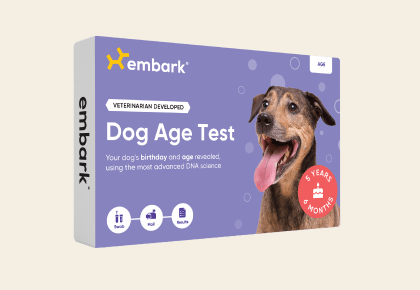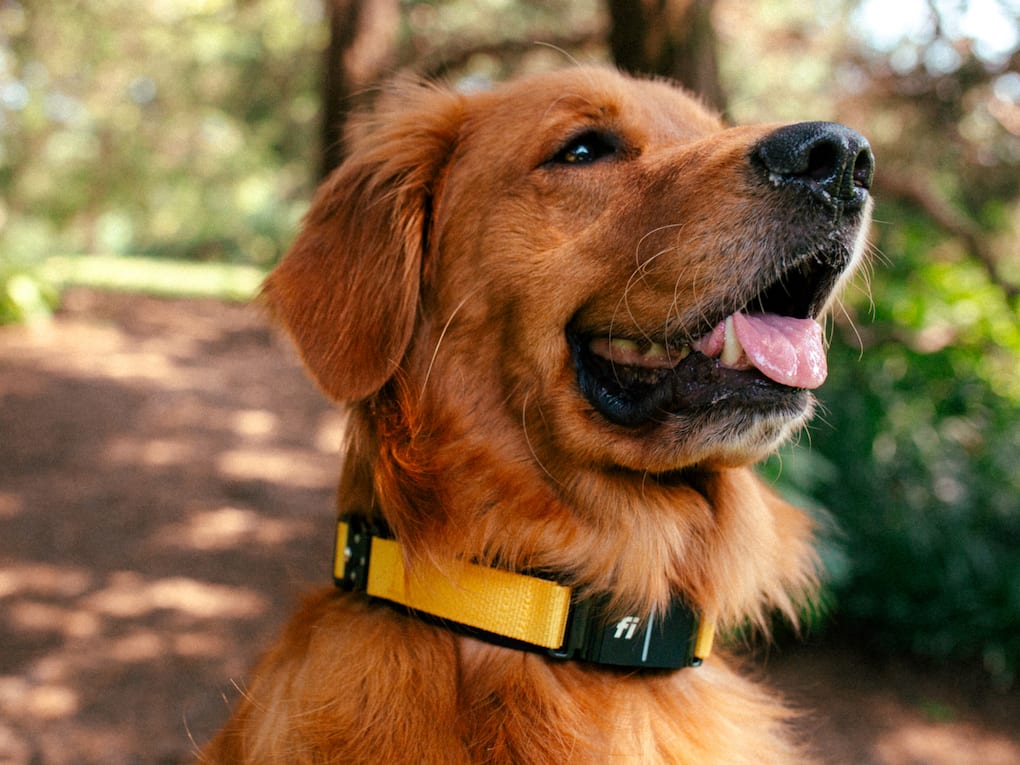It should surprise no dog lover that dogs, just like people, live longer and healthier lives if they stay in great physical condition. Physical exercise has many benefits for dogs—not only does it help them stay fit; it also helps to exercise their brain.
Daily walks or games of fetch are a good start, but how do you know if your dog is getting enough exercise? A GPS dog collar can help.
How much exercise does a dog need?
Dogs have vastly different exercise needs, depending on the individual and their size, breed, age, and more. Which dogs get the most exercise? According to Embark data, the Wirehaired Pointing Griffon, Stabyhoun, and Armenian Gampr are among the breeds that get the most exercise, as are the Newfypoo, Pomsky, and Sheepadoodle.
Not sure what your dog’s breed mix is? Find out with an Embark Dog DNA Test.
Talk to your veterinarian about how much daily activity is right for your dog, considering their individual health. Once you have a good idea of your dog’s daily activity goals, a dog GPS tracker—like the Fi Smart Dog Collar—can help your dog meet them.
How a GPS dog collar can track your dog’s activity level
It’s unlikely that you have the time to count each one of your dog’s steps throughout the day. So how are you supposed to figure out just how much physical activity they’re getting? The answer is a global positioning system (GPS) tracker for your dog. Much like the fitness trackers designed for humans, these activity trackers record the amount of movement your dog makes throughout the day.
By using a dog GPS collar, or attaching a tracker to your dog’s existing collar, you can track and record their movement throughout the day. With it, you discover just how active your dog is while you are away from home or while you are sleeping. If your dog sleeps most of the time you are at work, then you will need to set aside time for getting them some exercise during the times that you are home. Most dogs don’t need rigorous CrossFit-like training. Consistent, low-level cardiovascular activity (like a decently long walk) is usually adequate and less likely to result in injury.
How a dog GPS tracker works
When you place a GPS device on your dog, it can give you an accurate location on a map in real time. The GPS device can be accessed through your smartphone (with a downloadable app) or your computer. More than just tracking your dog’s current location, the GPS tracker will record the distance your dog moves throughout the day plus their daily step count.
To be clear, a GPS dog tracker is not the same thing as an RFID (radio-frequency identification) chip. The microchips that are implanted under your pet’s skin have no power of their own and cannot be used to track the wearer’s location. They cannot provide any real-time information about your pet’s location (unless scanned) or track their movements. These chips can register your pet’s chip number and your contact information. If a chipped animal is found, the chip can be scanned and the owner contacted.
How to use a dog GPS tracker to manage your dog’s health
Dog GPS trackers, like the Fi Smart Dog Collar, offer many benefits to the dogs who wear them and their owners. These smart collar options provide you with many ways to monitor and manage your dog’s overall fitness and health. Here are nine examples.
1. Ensure your dog is getting all of their steps
The concept of the correct number of “steps” isn’t entirely accurate for pets because smaller dogs may need to take many more steps than larger ones to cover the same area. Although each breed and individual may have different activity requirements, a GPS dog collar can still provide you with insight into how much activity your dog is getting. Whether it’s running in circles at the dog park, taking long leisurely walks with you, or touring the fence line in the backyard, every movement your dog makes will be recorded.
Talk to your vet to find out what fitness goals you should set for your dog based on their breed, age, and health. Once you have determined the best activity level for your dog, you can program this information into your dog’s GPS tracker using your smartphone or computer. Daily check-ins will help determine if your dog is getting enough exercise. Some GPS tracker programs even send you an alert if the day is nearing its end and your dog hasn’t reached their desired activity level.
2. Calculate calorie consumption
This is particularly helpful for overweight dogs who need to slim down to stay healthy, but it can be helpful for any dog. The more active a dog is, the more calories they need to consume to maintain their weight. For dogs who need to lose a few pounds, the activity tracker will let you know whether you should reduce your dog’s daily food intake based on how many calories they are burning through movement.
The exact number of calories relative to the amount of activity is something that you and your vet can decide based on your dog’s current fitness level, age, and breed.
3. Determine if behaviors are related to activity levels
Chewing on hazardous materials or darting out the door to run free can risk your dog’s health. These and other problem behaviors are more likely to occur if your dog is not getting enough physical or mental exercise.
By tracking your dog’s activity levels and comparing them to the times when risky behaviors occur, you should be able to see if a lack of exercise is contributing to the behavior. If so, you and your dog will be a lot happier and healthier if you ensure they get enough exercise each day.
4. Identify changes in activity
By monitoring your dog’s activity levels regularly, you can take note of trends and averages. Monitoring these trends will alert you to any changes. If your dog’s activity level drops off unexpectedly or begins to trend downward, it may be a sign that something is wrong. At this point, a phone call to your vet is warranted.
Even if you have not seen a change in your dog’s activity level, showing your vet the recorded activity levels at your dog’s annual exam is a good idea. This will give your vet a clear view of how much activity your dog is getting and give you a starting point for conversations about just how much exercise is the right amount for your dog.
5. Identify signs of pain or discomfort
Some dogs may have a tendency to be stoic, and won’t complain about physical discomfort unless it is extreme or may ignore discomfort if it gives them the chance to play with you. They may show their pain or discomfort when you are away or overnight. Many dogs spend most of these quiet times resting. If you notice that your dog is no longer sleeping through the night, spends time pacing back and forth, or is getting up frequently to reposition themselves, it may be a sign that they are uncomfortable.
If you discover these new patterns of behavior, watch your dog closely for signs of pain, including limping, reduced interest in active games, not eating, and general malaise. If you see these signs or just have a sense that something is not right, schedule an appointment with your vet.
6. Identify signs of cognitive impairment
Older dogs can suffer from senile behaviors just like their human counterparts. The symptoms are more difficult to recognize in dogs as we cannot know if they are suffering from short-term memory loss or confusion about the identity of those around them. One common symptom of cognitive dysfunction in dogs is a perceived confusion between day and night. Dogs suffering from this symptom may become nocturnal, sleeping most of the day and getting up in the night to do daytime activities like eating and going to the bathroom.
If you have a senior dog and you notice that their times of activity have reversed, with them being more active at night than during the day, they may be exhibiting signs of canine cognitive dysfunction. Talk to your vet for a diagnosis and to find out how best to care for them.
An additional benefit to having a GPS tracker on a dog is the ease of locating them if they wander off. A dog with cognitive dysfunction may be more likely to be unable to find their way home on their own. If your dog is fitted with a GPS dog collar, you should be able to find them no matter how lost they feel.
7. Incorporate the GPS data into an overall health review
Whether or not you see any problems with your dog’s activity reports, take them with you to your vet visits. The vet may see patterns or issues that you do not. Even if everything is fine, these records provide the vet with a snapshot of your dog’s daily life that can be invaluable if problems arise in the future.
8. Monitor dog health
Some dog GPS trackers offer more than just location tracking. A few have additional software and technology designed to monitor your dog’s health. For example, the Fi app features always-on behavior tracking, plus escape alerts, activity updates, and sleep stats, so you can keep up with your dog’s activity and identify potential health concerns.
9. Locate a lost dog
If your dog gets out of the yard or bolts out an open door, the safest course of action is to find them and get them back home as soon as possible. The problem is that dogs can move very quickly. By the time you get the leash and set out to look for them, they may already be far away.
The movements of a dog off the leash are also very unpredictable. With their newfound freedom, they will likely take off in whatever direction the best smells come from. This may mean crossing streets, following vehicles or trains, or traveling far into unfamiliar territory. All of these activities can be dangerous.
A dog activity tracker that is connected to the GPS can help you locate a lost dog. Because you get real-time readings from the GPS tracker, you can get the exact location of your dog if they wander away from home. One caveat to this is that the GPS tracker uses cell phone technology to send its signal. If you or your dog are outside of the service area of the cell phone carrier you use, you will not be able to track your dog until both of you have returned to the service area.
By logging into your dog’s GPS tracker app, you can get real-time updates about your dog’s location. This means no more fruitless wandering for you and no more guessing where they may end up. Just locate them with the app and go pick them up.
A dog GPS tracker can be a wise investment in your dog’s health
The actual cost for the equipment and service for a dog GPS collar can vary depending on the brand and features you choose. They usually involve purchasing both the GPS collar and a monthly subscription to keep it active. If you are like most dog owners, the cost of keeping your beloved pet safe is well worth it. When you consider all the advantages this technology provides to both you and your dog, you will likely agree that a high-quality GPS collar is a wise investment in your dog’s health.














